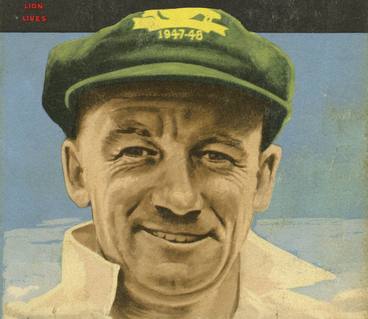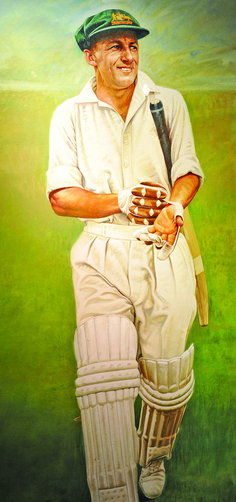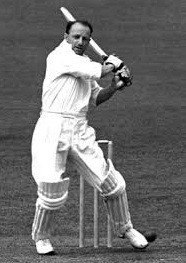
I wonder if anyone else remembers the BBC television program shown on the ABC many years ago, a historical drama about the rise and fall of King Edward VIII? I have forgotten the title. But I do remember the theme song. It was a 1920s hit ‘I danced with a man who danced with a girl who danced with the Prince of Wales!’ I am reminded of this line when I reflect on my association with the cricketing icon Don Bradman.
Yes, I knew Bradman … although it was only at second and third-hand.
At second-hand is my friend Gil Field, a colleague in departmental days. Gil told me once that when he had been a boy growing up in South Australia in the early 1950s, his father had taken him to the Adelaide Oval one day and contrived to introduce him to The Don. Gil was only about six years old at the time, but still remembers the great man gravely shaking his hand, and the awe which surrounded the occasion. It became a highlight in the Field family history. To his father’s chagrin, the experience did not lead to Gil becoming a champion international cricketer, although I do not share that disappointment. It would have robbed us of Gil becoming one of Australia’s most gifted park rangers and an expert in environmental interpretation.
 I also have a second-hand contact with Bradman through another old friend, the late Peter Hill. Peter also met The Don when he was a boy. This was before the war, in the 1930s. Peter’s father had taken him to Myer store in Melbourne, where Bradman was signing cricket bats under some sponsorship arrangement. Peter’s signed cricket bat has survived the years, bequeathed by him to me, and it is beside me as I write, complete with the great man’s faded signature. Occasionally I pick it up, reminding myself that this is a bat once held by Bradman, and I swish an imaginary cover drive or a pull through midwicket. As with Gil, the Bradman meeting failed to ignite an international cricketing career for Peter Hill. He became a scholar, musician and diplomat and spent most of his career in exotic places around the globe as a member of the Australian Diplomatic Corps, not as a member of the Australian Cricket Team.
I also have a second-hand contact with Bradman through another old friend, the late Peter Hill. Peter also met The Don when he was a boy. This was before the war, in the 1930s. Peter’s father had taken him to Myer store in Melbourne, where Bradman was signing cricket bats under some sponsorship arrangement. Peter’s signed cricket bat has survived the years, bequeathed by him to me, and it is beside me as I write, complete with the great man’s faded signature. Occasionally I pick it up, reminding myself that this is a bat once held by Bradman, and I swish an imaginary cover drive or a pull through midwicket. As with Gil, the Bradman meeting failed to ignite an international cricketing career for Peter Hill. He became a scholar, musician and diplomat and spent most of his career in exotic places around the globe as a member of the Australian Diplomatic Corps, not as a member of the Australian Cricket Team.
Finally, and here we are at three degrees of separation, there is my former forestry colleague and good friend Donald George Begbie. He was named by his father after Donald George Bradman. I don’t recall that Don Begbie ever met Don Bradman, but he has a connection nevertheless. Don (Begbie, that is) once lived next door to Lindsay Hassett, a member of Bradman’s all-conquering 1948 Ashes team, and Bradman’s successor as Australian cricket captain. More than this, Don Begbie actually once bowled to Hassett in a game of cricket. True, it was beach-cricket which Hassett (long retired at that point) had been persuaded briefly to join by the neighbourhood kids. Hassett faced one ball, and cut Don’s innocuous off-spinner away into the surf. Remarking “I’ll take four for that” Hassett retired and adjourned to his garden shed. The shed doubled as a wine-cellar, and was well-stocked.
My father lived through the peak of the Bradman era, and watched him bat in the famous series in England in 1930, but he did not greatly admire him. Perhaps he was influenced by a book critical of Bradman written by Jack Fingleton which knocked around our house when I was a boy. Fingleton, like most of The Don’s team-mates always put Bradman on a pedestal for his batsmanship, but had little time for Bradman-the-man, regarding him as aloof, driven and self-centred.
Perhaps my father also saw Bradman as calculating and ruthless (characteristics he deplored), and compared him unfavourably to the free-flowing devil-may-care type of cricketer exemplified by Keith Miller. My father would certainly never have gone out of his way to meet Bradman, nor taken me to shake his hand.
Some of this has rubbed off on me. I am not a Bradman worshipper, although I acknowledge his batting prowess, achievements and, especially, his cricketing supremacy. Like so many, I have made the pilgrimage to the Bradman Museum in Bowral. And I am always irritated by the naive journalists who today compare David Warner or Steve Smith with The Don. Few people these days, even those familiar with the statistics of his batting career, really appreciate the degree to which Bradman dominated the game or the way in which he could reduce a world-class bowling attack to impotence. I once read a good story in an old cricket book that exemplified this, and it still makes me smile. The ‘Little Fella’ in the story is, of course, Bradman.
Leg spinner Bill Tallon, whose brother Don was a famous Australian wicketkeeper, loved to tell a story about a time he and his brother were both playing for Queensland in a Sheffield Shield match against South Australia. “South Australia had been sent in to bat. My brother Don caught Tom Klose. One for none. The Little Fella came in and turned a single to leg. One for one. We got Ron Hammence out for a couple. Two for three.
Bill paused at this point and had a pull on his beer.
“Bradman went for a big hit and skied it over mid-wicket. Circling under it I thought to myself ‘Don’t miss this one’. I caught it, and looked at the scoreboard. Three for 480.
 This was the thing about The Don; he tore attacks to shreds without seeming to do so, almost without you noticing. The thing that characterised a Bradman innings was the relentless accumulation of singles, twos and threes, the glides past gully and the effortlessly knocking of the ball into gaps in the field. When Bradman was batting, the scoreboard just kept ticking over. The Don during the 1948 tour to England. He was a wonderful accumulator of runs but was also a master of the ruthless pull through mid-wicket and a fearless hooker.
This was the thing about The Don; he tore attacks to shreds without seeming to do so, almost without you noticing. The thing that characterised a Bradman innings was the relentless accumulation of singles, twos and threes, the glides past gully and the effortlessly knocking of the ball into gaps in the field. When Bradman was batting, the scoreboard just kept ticking over. The Don during the 1948 tour to England. He was a wonderful accumulator of runs but was also a master of the ruthless pull through mid-wicket and a fearless hooker.
There was another factor. England fast bowler Harold Larwood once commented on what he called the “cruelty” of Bradman. “He flogged us when we were down” said Larwood. He also observed how Bradman would pick on an individual fielder (for example the rotund England spinner Tydesley) and tease him over and over again with strokes just to his left or to his right, always making him give up the single, always making him run.
I have recently read The Incomparable Game by the wonderful England cricketer Colin Cowdrey, and in it he tells an amusing story about Bradman, commencing with observations made (Cowdrey was aged 15) when watching Bradman’s last innings (in 1948) at Lord’s:
As fast as any Englishman in that period of no fast bowlers was, I suppose, Bill Edrich. Sitting at Lord’s watching him on the occasion of Bradman’s last innings on the ground, I was filled with that sense of awe that comes to every schoolboy when he sees a bowler he considers fast enough to be fearsome. Edrich, aggressive, fit, terribly busy in his run up, made me think then that it would be impossible for me to play in his class of cricket. He would have been too fast for me and I would never have seen the ball. He frightened me to death just to watch him run up.
This respect was transferred fairly quickly once Bradman got to the wicket and began to compile what everyone said was a typical hundred. The sight of him that sticks in my memory is of his counter to an Edrich bouncer. I don’t know whether he picked up a message from the bowler’s run up, but he took two little skipping steps away from the stumps and with a horizontal bat lathered the ball down the wicket so that it pitched almost at Edrich’s feet on his follow through and caused him to shuffle out of the way like a dancer. Then the ball took off past the umpire like a Bobby Locke low wedge shot and bounced back off the sightscreen at the Nursery End.
That stroke has remained in my memory like a photograph. It tells me everything I want to know about Bradman.
I have only once seen a batsman in First Class cricket playing the “straight pull” — flat batting a bouncer back at the bowler and endangering his and the umpire’s health. That was the great South African Barry Richards, then playing for South Australia at the WACA ground in Perth. Against bowlers of the caliber and pace of Graham McKenzie and Dennis Lillee, he had four options with the short ball aimed at his head, and he used them all: he could step away and cut it, flat bat it back past the bowler, pull it through mid-wicket or square leg, or hook it over fine leg. I had never seen such cool mastery.
But back to Bradman. Earlier, I made the comment that he was more an accumulator of runs than a master blaster. He would effortlessly keep the scoreboard ticking over with ones, twos and threes. Until I read Colin Cowdrey’s book I had not realised that he was also a magnificent hooker when the occasion arose. Cowdrey goes on:
I know that when they say he murdered even the best fast bowlers with his hook that it was true. I know also that it must be true when they claim that he was the greatest hooker the game has known.
There is a story of Bradman’s hooking which is now listed in the history of Kent as another example of man’s inhumanity to man. The victim was Fred Ridgway, the county’s fast bowler who had never seen the Don bat.
So at Canterbury in 1948, as Bradman [then aged 40] walked out to take guard, Godfrey Evans and Les Ames, two men whose combined knowledge of Bradman went back nearly twenty years, decided to give Fred some tactical advice.
“He’s got a reputation as a hooker,” said Evans, “but when you get to forty it’s a different business.” Turning to Ames he said: “You used to hook a bit, Les, didn’t you, but you had to give it away.” Ames nodded agreement.
“Give him a couple of good length ones around the off-stump,” advised Evans, “and then give him the bouncer third ball. You’ll get him caught at short-leg.”
Ridgway gave the third ball everything. So did Bradman. It pitched among the hydrangeas in front of the Mayor’s enclosure scattering the official party, skimmed past two waiters and bounced off the back wall of the tent.
In judging Bradman-the-man, rather than Bradman-the batsman, we need to take into account the unprecedented media attention directed at him, his international hero status and the extent of the public adoration, especially during the dark days of the Depression when many people were crying out for something uplifting. The Don needed to find a way to survive this, and perhaps when he chose not to be ‘one of the boys’ this was one of the ways he coped. Furthermore, first class cricket at Test and Sheffield Shield level is played hard. No prisoners are taken … especially none were taken by Donald Bradman.
I also admire his insight into the game. The commentator Richie Benaud related how he once asked Bradman what he thought of the new 50-over One Day game that was just coming into vogue. “I’m in favour of it” said Bradman, “it will lead to faster rates of scoring and an improved standard of fielding in Test and Shield cricket.” He was right, and had he been alive today would probably be making a similar observation about the advent of 20-20 cricket (to which I am only slowly warming).
Donald George Bradman is widely acknowledged as Australia’s greatest sportsman. I am pleased to be able to record my personal relationship with him (even though this was at arm’s length), thanks to my friends Gil Field, Peter Hill and Donald George Begbie … all of whom, given the chance, would have danced charmingly with a girl who had danced with the Prince of Wales.
Roger Underwood, a forester with fifty years experience in bushfire management, is Cchairman of The Bushfire Front, an independent professional group promoting best practice in bushfire management.
 Sign In
Sign In 0 Items (
0 Items ( Search
Search









Edward & Mrs. Simpson with Edward Fox.
A few years ago I read an article in which the author proposed that there was a good chance Bradman was on the spectrum (as they say in modern parlance).
Regarding short form cricket improving fielding, I have a theory that it improves outfielding and inner ring fielding, but does not improve cordon catching. Apart from the fact that there are generally no slips in F50 and T20, the increased pace of short form does not lend itself to the patience needed in slips on a long hot day where a chance may come out of the blue. So rather than improve Test slips catching, short form actually harms it. Or at least doesn’t improve it.
In my experience, it’s a very rare leader who has the common touch, able to retain the respect of all hands while mixing freely with them. In many years in the military, I’ve known only a couple of such people. Familiarity really does breed contempt. Bill O’Reilly was another who frequently voiced his negative opinion of Bradman as a person, but there was more than a hint of religious bigotry there, on both sides.
I just think that, socially, he was the product of his much more formal times. Keith Miller was more of an aberration than Bradman and, I think, a much less admirable character.
With O’Reilly it wasn’t just the religious bigotry issue (although this was a big part of it) but his resentment of the treatment of Clarry Grimmett. Grimmest took 44 wickets in South Africa in 35/36 (still, I believe, the Australian series record), but was dumped for the next test series (against England, and Bradman’s first as Captain), and never played another test, even though he set the season record for Shield wickets that following season! No convincing reason was ever given for Grimmett’s dropping. Bradman himself made a few comments about Grimmett having an inferior strike rate to the leg spinners that were taken on the Ashes tour of 1938, but it didn’t quite gel given the comparison of wickets taken in a series.
Apparently Dennis Compton once said that a player like Bradman is not a player that comes along once in a lifetime, but once in the lifetime of a game. With the distance and additional test countries, it seems more and more certain he was right.
I had the good fortune to meet Bill Brown at a Steve Waugh fundraiser in about 2008. Bill was a small man, of course quite elderly but very spry. Two remarkable things about my meeting with Bill; he had the smallest hands of any man I have ever met. Also during our conversation, Bill never referred to Don Bradman other than as The Great Man.
To this day, I am uncertain whether he used this term to show his respect for Don Bradman or tongue in cheek.
I asked for a Bradman story. Bill told me when he first went in to bat with Don Bradman he was very nervous.
The Great Man was already at the wicket at the bowler’s end. Bill said he managed to make a few runs and saw the over out with his wicket intact.
At the change, The Great Man beckoned him down for a mid wicket conference. Bill, The Great Man said, you are going well, but please do not forget to call.
My father knew “the great man” when they were at Kelvinators. Dad never like him much, because he said some of his dealings as a stockbroker were shonky.